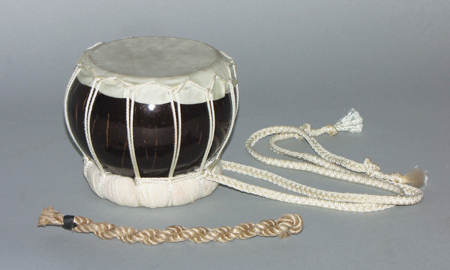
Owner: HWMC
Catalog#: OC-MBST-28
Struck Membranophones
Hawaiian 'Puniu' Drum & 'Ka'
Hawaiian Islands
Polynesia
Coconut shell, hide, rattan
ca. 1980s
Height: 4 in; Diameter 4.5 in
Membranophones – Directly Struck
The puniu was constructed from the shell of a niu, or coconut. The stem end was cut off and the skin of a shark or kala fish was placed over the opening, forming a drumhead. The head was attached to the coconut shell by typing it to a ring placed on the bottom side.
The puniu pictured here has a ring made of kapa, a cloth manufactured throughout the Pacific that was also used by Hawaiians to make mats and clothing. In old accounts, the puniu is played only in tandem with the pahu hula. The larger drum was sounded with the chanter’s left hand, and the puniu, tied to the right knee, was played using a beater of twisted coconut fibers or braided lau ki called the ‘ka’. Because it was usually played with the pahu drum, the high-pitched puniu would have been used in the sacred hula pahu dances. For contemporary kumu hula, the teachers and composers of hula, now occasionally compose for the puniu as a stand-alone instrument.
The puniu is unique among Hawaiian instruments, because unlike the pahu hula, which has its roots in East Polynesia, the puniu is not found anywhere else in the Pacific. This indicates that it is one of the few locally invented Hawaiian instruments.
Resource: “Puniu,’ Zaneta Ho’oulu Cambra, ‘Groves Dictionary of Musical Instruments,’ 2nd Ed. Laaurence Libin, Editor in Chief, Oxford University Press. Vol. 4, pp 177-178.
